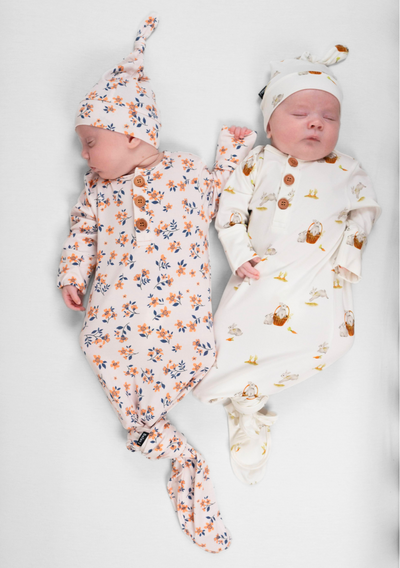Are Sleep Sacks Safe for Babies? Sleep Sack Safety Tips
As a new parent, you're likely concerned about keeping your little one safe while they sleep.
Sleep sacks are a popular choice for many parents, as they provide a safe and cozy sleeping environment for babies.
However, it's important to use them correctly to ensure your baby's safety.
In this helpful guide, we'll share some sleep sack safety tips every parent should know.
Don't forget to take a look at our bamboo sleep sacks - available right here at Belan-J.
What is a Sleep Sack?
A sleep sack, often referred to as a sleep bag or baby sleep sack, is a practical and safe alternative to traditional baby blankets. It serves as a wearable blanket designed to keep your baby snug and secure while they sleep.
Made from soft and breathable materials like bamboo or cotton, sleep sacks come in various styles with easy-to-use closures, such as zippers or snaps, making them a convenient choice for parents.
The primary appeal of sleep sacks lies in their safety features, as they eliminate the risk of loose blankets, reducing the chance of Sudden Infant Death Syndrome (SIDS).
They also help maintain a consistent and comfortable sleep environment, ensuring your baby sleeps soundly while allowing for easy diaper changes with features like two-way zippers.
Additionally, sleep sacks are versatile, available in different thicknesses suitable for all seasons, and add a touch of style with their adorable designs, like the beloved bear-themed sleep sacks.
Are Sleep Sacks Safe For Babies?
Yes, sleep sacks are safe for babies when used correctly. Sleep sacks are designed to provide a safe and cozy sleeping environment for babies.
Sleep sacks provide a safer sleeping environment for babies in multiple ways, ensuring peace of mind for parents. Let's take a look at some unique advantages of sleep sacks.
The Warmth of Blankets Without the Risk
Unlike loose blankets, which can pose suffocation and strangulation hazards, sleep sacks offer the cozy comfort of a blanket without the associated risks.
The American Academy of Pediatrics advises against using blankets in cribs for infants under 12 months old, making sleep sacks a safer alternative.
So, save those baby blankets for supervised playtime and opt for a sleep sack during sleep.
Ease of Rolling Over
Most sleep sacks are sleeveless, allowing infants to have their arms free.
This design enables them to use their arms to roll themselves back if they accidentally end up on their belly.
Rolling over and ending up face down in bed increases the risk of suffocation and SIDS, making sleep sacks a valuable safety measure.
Healthier Hips
Sleep sacks with a bit of roominess give babies the freedom to kick their legs, promoting healthy hip development.
Tight swaddling or wrapping can potentially lead to hip dislocation or hip dysplasia.
Sleep sacks, with their relaxed fit, allow for natural movement while keeping your little one snug and secure.
Why Do Parents Think Sleep Sacks Aren't Safe?
Why do some moms have concerns about the safety of sleep sacks for their little ones?
Well, it's important to mention that sleep sacks are generally considered safe and even recommended by pediatricians to ensure our precious ones sleep soundly.
However, there might be a few reasons why some moms might feel a bit uneasy:
Awareness Gap: Sometimes, as moms, we may not be fully aware of what sleep sacks are and how they can benefit our babies. A little education and information can go a long way in addressing these concerns.
Getting the Right Fit: Selecting the perfect size and fit for a sleep sack is crucial for safety. If it's too big or too snug, it may not provide the desired safety benefits. Ensuring we pick the right size for our baby's age and weight is key.
Temperature Worries: We all want our little ones to be just the right temperature. Some of us may worry that our baby could get too warm in a sleep sack, potentially leading to overheating. The trick is to choose a sleep sack with the appropriate TOG rating for the room temperature and season.
Freedom of Movement: As moms, we may be concerned that sleep sacks might restrict our baby's movements. However, rest assured that sleep sacks are cleverly designed to allow for leg movement while providing that cozy and secure sleeping environment we want for our babies.
Transitioning from Swaddling: For those of us transitioning our babies from swaddling to sleep sacks, there might be an adjustment period. It's a good idea to follow safe sleep guidelines during this transition to make sure our little ones are comfortable and secure.
Special Circumstances: In rare cases, a pediatrician may have specific recommendations related to a baby's medical condition or development, and they might advise against using a sleep sack. As moms, it's important to follow the guidance of our healthcare providers in such cases.
To address these concerns, we can empower ourselves with knowledge about safe sleep practices and choose sleep sacks that meet the highest safety standards.
Following guidelines provided by trusted sources like the American Academy of Pediatrics (AAP) can help us ensure our little ones sleep safely and soundly, giving us peace of mind as moms.
Sleep Sacks vs Swaddling: Which is Better?
When it comes to the choice between sleep sacks and swaddling for our precious babies, some moms may find themselves pondering the best option.
Sleep sacks, also known as wearable blankets, are generally considered safe and recommended by pediatricians to provide a secure and cozy sleeping environment for infants.
They eliminate the risks associated with loose blankets and allow for safe leg movement, making them a popular choice.
On the other hand, swaddling involves tightly wrapping a baby in a blanket or cloth to restrict their movement, mimicking the womb's snug feeling. While swaddling can provide comfort and help calm a fussy baby, it's essential to follow proper swaddling techniques to avoid overheating or hip dysplasia risks.
Ultimately, the choice between sleep sacks and swaddling may depend on a baby's age, preference, and developmental stage. Some parents even choose to transition from swaddling to sleep sacks as their baby grows and becomes more active.
Both options can be safe and beneficial when used correctly, so it's essential to consider your baby's specific needs and preferences to make the best choice for their sleep routine.
Helpful Tips for Using a Sleep Sack
Here are some helpful tips for using a sleep sack to ensure your baby sleeps safely and comfortably:
Choose the Right Size: Ensure the sleep sack fits your baby properly. It should be snug but not too tight, allowing room for your baby's legs to move freely. Most sleep sacks come in different sizes based on your baby's age and weight.
Consider the TOG Rating: Pay attention to the TOG rating, which indicates the thickness and warmth of the sleep sack. Select a sleep sack with an appropriate TOG rating for the room temperature and season. This helps prevent your baby from overheating or getting too cold.
Dress Appropriately: Dress your baby in suitable clothing underneath the sleep sack based on the room temperature. In warmer weather, a lightweight onesie may be sufficient, while colder temperatures may require a warmer layer.
Ensure Proper Placement: Always ensure that the sleep sack is placed securely on your baby. The neckline should fit comfortably around your baby's shoulders, with no loose fabric that could cover their face. Make sure the sleep sack is zipped or fastened correctly to prevent any accidental openings.
Monitor Room Temperature: Keep an eye on the room temperature to ensure your baby stays comfortable. Avoid using heavy blankets or quilts in addition to the sleep sack, as this can lead to overheating.
Transition Gradually: If your baby has been swaddled and you're transitioning to a sleep sack, do so gradually. Start by leaving one arm out of the swaddle and then both arms before introducing the sleep sack.
Check for Wear and Tear: Regularly inspect the sleep sack for any signs of wear and tear, such as frayed seams or broken zippers. Replace it if you notice any damage to ensure continued safety.
Follow Safe Sleep Guidelines: Always follow the safe sleep guidelines recommended by organizations like the American Academy of Pediatrics (AAP). These guidelines emphasize placing your baby on their back to sleep in a crib or bassinet with no loose bedding, including pillows or stuffed animals.
By following these sleep sack safety tips, you can provide your baby with a secure and comfortable sleep environment, ensuring peaceful nights and peace of mind for both you and your little one.
Your Sleep Sack Safety Questions, Answered
Is it safe for babies to sleep in sleep sacks?
Yes, sleep sacks are safe for babies to sleep in when used correctly. Sleep sacks are designed to provide a safe and cozy sleeping environment for babies, while reducing the risk of suffocation and Sudden Infant Death Syndrome (SIDS).
However, it's important to use them correctly and follow the manufacturer's guidelines to ensure your baby's safety.
At what age are sleep sacks safe?
Sleep sacks are safe for babies from birth up to about 12 months of age.
After that, most babies can start using a blanket, but some may prefer to continue using a sleep sack.
It's important to choose the appropriate size and fit for your baby, and always follow the manufacturer's guidelines for safe use.
What are the negatives of sleep sacks?
While sleep sacks are generally safe and beneficial for babies, there are some potential negatives to consider.
One common concern is overheating, especially if the sleep sack is too warm for the environment or the baby is wearing too many layers underneath.
Another concern is the potential for tripping or falling if the sleep sack is too long or too loose
Should I use sleep sack or not?
Whether or not to use a sleep sack for your baby is a personal choice.
Sleep sacks can provide a safe and cozy sleeping environment for babies, while also reducing the risk of SIDS.
However, some parents may prefer to use a traditional blanket or swaddle.
Ultimately, the decision to use a sleep sack or not should be based on what works best for you and your baby, and what makes you feel most comfortable and confident.
Staying Safe with a Sleep Sack
Sleep sacks are a great choice for parents who want to provide a safe and cozy sleeping environment for their babies.
When using a sleep sack, it's important to choose the right size and fit, opt for a sleeveless design, check for loose fabric and snaps, choose breathable fabric, and never use a sleep sack with a swaddle.
By following these sleep sack safety tips, you can ensure your baby sleeps safely and comfortably.



